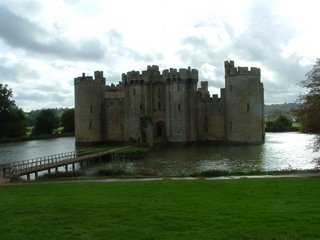


The start of the mid term holiday - and we decided to make a weekend visit to Sussex which is South West of here. The National Trust and English Heritage have a host of sites in that area, and we felt it worthwhile to spend a night away to see as many as we could. Most of the sites close down at the end of October for the "Winter" break.
We started off at Bodiam, the site of what is described as "the Finest Ruined Castle in England". It was built between 1385-90 by a Gentleman soldier Sir Edward Dalyngrigge who had accumulated a fortune fighting in France. He married well and through this marriage acquired the land on which he built his castle. Not only did he plan the building as a defense against possible French invasion, but he made sure that it was a classical home for he and his wife. The castle stands surrounded by a wide and deep moat and is immediately impressive. Sadly for Edward, he decided to make another trip to France to fight more battles, and on his final return he lived but a few years to enjoy his estate having spent 15 years of his short life fighting the French - but he did have the good sense to marry well!
As usual the bloody Roundheads attacked the castle in 1645 and as was their trademark, partially destroyed this magnificent structure. It continued in disrepair for many years until finally it was bought by Lord Curzon, who had retired from his role as Viceroy of India, and fell in love with Bodiam as soon as he saw it. This was in 1917 and he spent considerable wealth on restoring and renovation until his death in 1925. It was left to the National Trust upon his death.
Bodiam featured in Roman tiimes, and they sailed their ships up the River to Bodiam which is hard to believe when one sees the present river which is lttle more than a creek,
Next stop was the little village of Burwash which we decided would be a good overnight stop. We booked into the Rose and Crown, an ancient Pub with a nice en suite bedroom and a good looking menu. Then we went to visit the house known as "Bateman's" that was lived in by Rudyard Kipling . Photo top left.
The house was built in 1634 of the local sandstone, and Kipling and his wife lived here from 1902 until his death in 1936. The beautiful house exuded the calm tranquility that he needed to write, and the magnificent gardens were where his wife spent many enjoyable hours. The house and all its contents was given to the National Trust in 1938 when Kipling's wife died. Two of their three children had predeceased them, and the surviving daughter had married well and lived in Wimpole House (see Blogsite "Sunday November 20th) which is probably why the National Trust was given this wonderful Heritage item. The furniture is original, there are many many items of memorabillia, including the Nobel Peace Prize for Literature which Kipling won in 1907. The prizemoney was 7,700 pounds - a substantial sum of money in those days.
In a garage rests the 1923 Roll Royce Silver Shadow which Kipling bought to order for 2,300 pounds, a sum which included two spare tyres! An enthusiastic motorist, it is odd that he never actually drove his cars!!
Then back to the Rose and Crown, a pint of the local brew, a first class meal of Dover Sole for me and Lobster for the Missus -followed by Fudge pudding - slept like a log!
Sadly the following day was wet, wet and more wet. After a breakfast in the traditional English style, we drove down to the coast and along to Brighton. En route we stopped at a lookout high up from where we could see the white cliffs and a huge sea pounding the coastline. Brighton was tantalising but we reluctantly decided that getting wet was not an option, so we have bookmarked a return visit to this area in the Spring of next year.
No comments:
Post a Comment